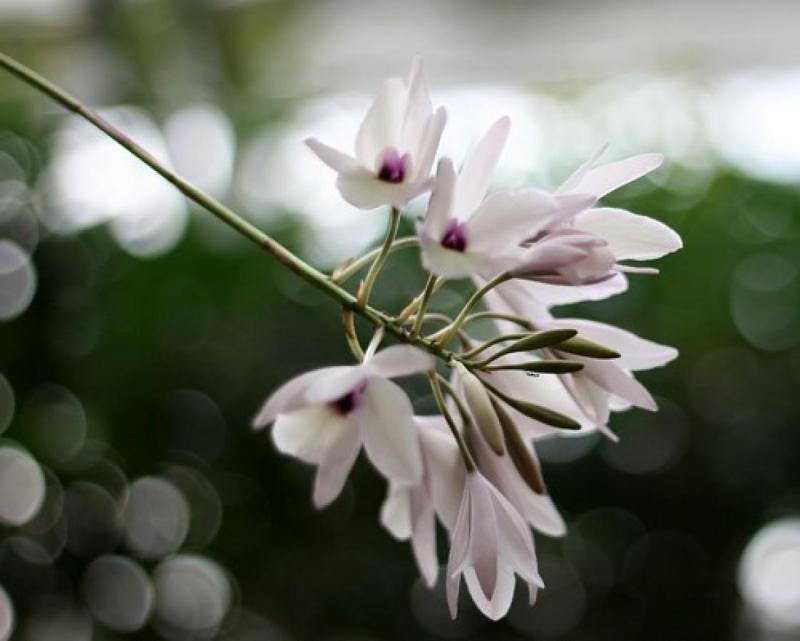Laelia rubescens
Also known as: Rosy Tinted Laelia or Laelia rubescens h.f. semialba Laelia acuminata h.f. rosea Laelia rubescens h.f. alba Schomburgkia rubescens f. peduncularis Laelia rubescens h.f. albescens Cattleya acuminata Laelia violacea Laelia pubescens Cattleya peduncularis Encabarcenia rubescens f. peduncularis Encabarcenia rubescens f. alba Laelia inconspicua Bletia peduncularis Laelia acuminata Amalia peduncularis Laelia peduncularis Bletia violacea Bletia acuminata Amalia acuminata Laelia rubescens f. peduncularis In Mexico Guarita in the subfamily: Epidendroideae
Native to: Belize Campeche - Mexico Chiapas - Mexico Colima - Mexico Guerrero - Mexico Honduras México - Mexico Nayarit - Mexico Oaxaca - Mexico Panama Puebla - Mexico Veracruz - Mexico
General Information
Rosy Tinted Laelia is a sympodial cool to warm growing epiphytic orchid belonging to the sub family Epidendroideae native to Belize, Mexico, Honduras, and Panama.
Plant Description
Sympodial. Grows to 17-28cm. Each new growth has a single leathery thick, rigid leaf that grows to 3-20cm long. Pseudobulbs grow to 5-7.5cm
Flowers
Numerous fragrant blossoms appear during Summer and Winter
Fragrance
The orchid is fragrant. The fragrance can be described as peculiar
Blooming Season
- Summer
- Winter
Substrate(s)
- Coarse
- Bark
Care Notes
This orchid goes into a dormancy phase during winter, during this phase it is best not to provide water unless the plant is starting to look thirsty. The lack of water increases the chance of flowering in spring, and also reduces the likelihood of any rot forming. Do not resume watering until new growth has appeared and is growing strongly.
Often a period of intense growth occurs after dormancy. During this time the amount of light, water and fertiliser the plant receives will directly impact the amount of growth that occurs during this time, and in the case of seedlings, will reduce the time required to reach maturity.
It's recommended to heavily reduce the water amount at the middle to end of autumn to trigger dormancy. Leaves on older bulbs will begin to drop during this time while the newer bulbs continue to mature until terminal leaves appear at the tip of the pseudobulbs.
Repotting can be done any time of the year though it's best to do it in early spring when new growth is appearing as this also means new roots will appear to help the plant anchor into the new media and offset any damage to established roots during the repotting process.
Fragrant:
- IsFragrant
Climate
The orchids are well adapted for hot weather, accompanied by sporadic, unpredictable rainfall and a generally dry climate. They can tolerate a lot of neglect as they are quite used to it, however they can be prone to underwatering and may collapse in cold, wet weather.
For this reason it's best to dedicate a sheltered, protected area for them where the watering can be controlled, such as a corner of a greenhouse or in a sheltered balcony. They can also do well hung near the roof of a shadehouse or sheltered greenhouse where they receive the extra heat but not as much water as other plants.
Grows at low to high elevations. Rainfall ranges from 1mm to 203mm per day, heaviest in June and lightest in March. Humidity ranges from 63% to 79%, highest in September and lowest in April. Temperature ranges from 14C to 30C, highest in April (19C to 30C) and lowest in January (14C to 25C).Watering
Keep moisture levels up during hot weather as the plant is prone to dehydration
Fertiliser
dormant-medium-demand-orchid Be sure to flush out excess fertiliser by running water through the media regularly year round. Apply fertiliser regularly at half strength year round. Use a low Nitrogen fertiliser during Summer. Use a high Phosphorous fertiliser during Summer.
Potting
These plants are quite forgiving and will do well repotted ever 2-3 years. The mix should be coarse, well draining, and allow space for air to move and for roots to grow.
Alternatively, these plants will also do well mounted to tree fern or cork slabs, or mounted to trees.
Best time for repotting or mounting the orchids is the end of winter when new growths start to appear. Avoid repotting during hot weather,
Repotting is best done annually and in a pot the same size or only slightly larger than the previous one.




















